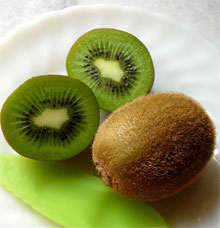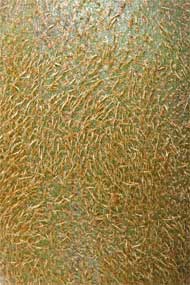Kiwi – the new superfood?

To Peel or Not to Peel, That is the Question.
You know Spring is in the air when these little fuzzy orbs, aka Chinese Gooseberries (it’s the national fruit of China), start making their debut in the produce displays. I have this distant and vague memory of hearing that “all the nutrition is in the skin” and remember that I used to eat kiwis whole like an apple because of that belief. Well, 20 years later, I am curious if that is true. And what exactly is the nutritional value of these beauties, inside AND out, anyway?
Serious Kiwi Nutrition
 There is a lot of information about kiwi fruit. In a nutshell, I was pleasantly surprised to learn that eating a kiwi is going to nourish my body with a load of dietary fiber, Vitamin E, Potassium, Copper, Vitamin C, and Vitamin K. They actually provide 273% of the recommended daily intake for Vitamin C. That is impressively one and a half times more “C” than an orange. And in case you forget why we need that vitamin, it has been known to boost the immune system, fight infection and repair certain body tissues. Kiwi competition doesn’t end there. It contains about as much potassium as a banana! Who knew?
There is a lot of information about kiwi fruit. In a nutshell, I was pleasantly surprised to learn that eating a kiwi is going to nourish my body with a load of dietary fiber, Vitamin E, Potassium, Copper, Vitamin C, and Vitamin K. They actually provide 273% of the recommended daily intake for Vitamin C. That is impressively one and a half times more “C” than an orange. And in case you forget why we need that vitamin, it has been known to boost the immune system, fight infection and repair certain body tissues. Kiwi competition doesn’t end there. It contains about as much potassium as a banana! Who knew?
So, how about the skin? Indeed, it is good for you, but it isn’t where ALL the nutritional value lies. It does, however, “contain an oil that is high in omega-3 fatty acids as well as alpha-linoleic acids“. These two essential acids are not produced by the body”. These acids are critical for joint, heart and metabolic health. The skin is also high in dietary fiber and is another source of flavonoid antioxidant.
More Facts
I found a lot of very intriguing facts about kiwis. Two are especially noteworthy. Raw kiwifruit is rich in actinidin, which is a protein-dissolving enzyme and can be an allergen for people who are allergic to latex, papayas or pineapples. Actinidin also makes the raw kiwifruit unsuitable for food combining with dairy and gelatin-based products because the enzyme quickly begins to digest the milk and collagen proteins, respectively, rendering them unsuitable for consumption.
The bottom line is people should be eating lots of kiwis (unless you’re on blood thinners; a University of Oslo study found that they thin the blood when consumed in quantity of 2 a day over a month period. If you are on blood thinners, consult your doctor about a safe quantity to eat – same thing with dark leafy greens). I’ve been experimenting with them in my green smoothies lately and have found that they are superb this way.
Here’s a green smoothie recipe I came up with. Enjoy!
1/2 Pear
1 ripe kiwi
Juice of 1 lime (or 1/2 if you don’t want it so tart)
1/4 cup cilantro, stems removed
~2 cups water (or to desired consistency)
Have you enjoyed Kiwi in your Green Smoothies?


2 Comments
Join the discussion and tell us your opinion.
Yes! I always add Kiwi’s to my green juice smoothie but will need to try your recipe, very interested too see how the cilantro tastes since I almost always include ginger.
Wow – I will be thinking differently of kiwis from now on. I had no idea they had such benefits.